Andy Warhol must be rolling over in his grave - a grave that is viewable 24-7 via this webcam. (Something, no doubt, that would have delighted the artist.)
On March 26th, a panel of the Second Circuit issued a decision finding not only that Warhol's unauthorized use of a photo taken by photographer Lynn Goldsmith to create a series of portraits of pop-icon Prince did not qualify as fair use as a matter of law, but also that Warhol's series was substantially similar to (and infringed upon) the plaintiff's photograph as a matter of law. #smackdown.
This timeline provides the pertinent facts of the dispute among Goldsmith, her photo agency Lynn Goldsmith, Ltd ("LGL"), and the Andy Warhol Foundation ("AWF" or the "Foundation"):
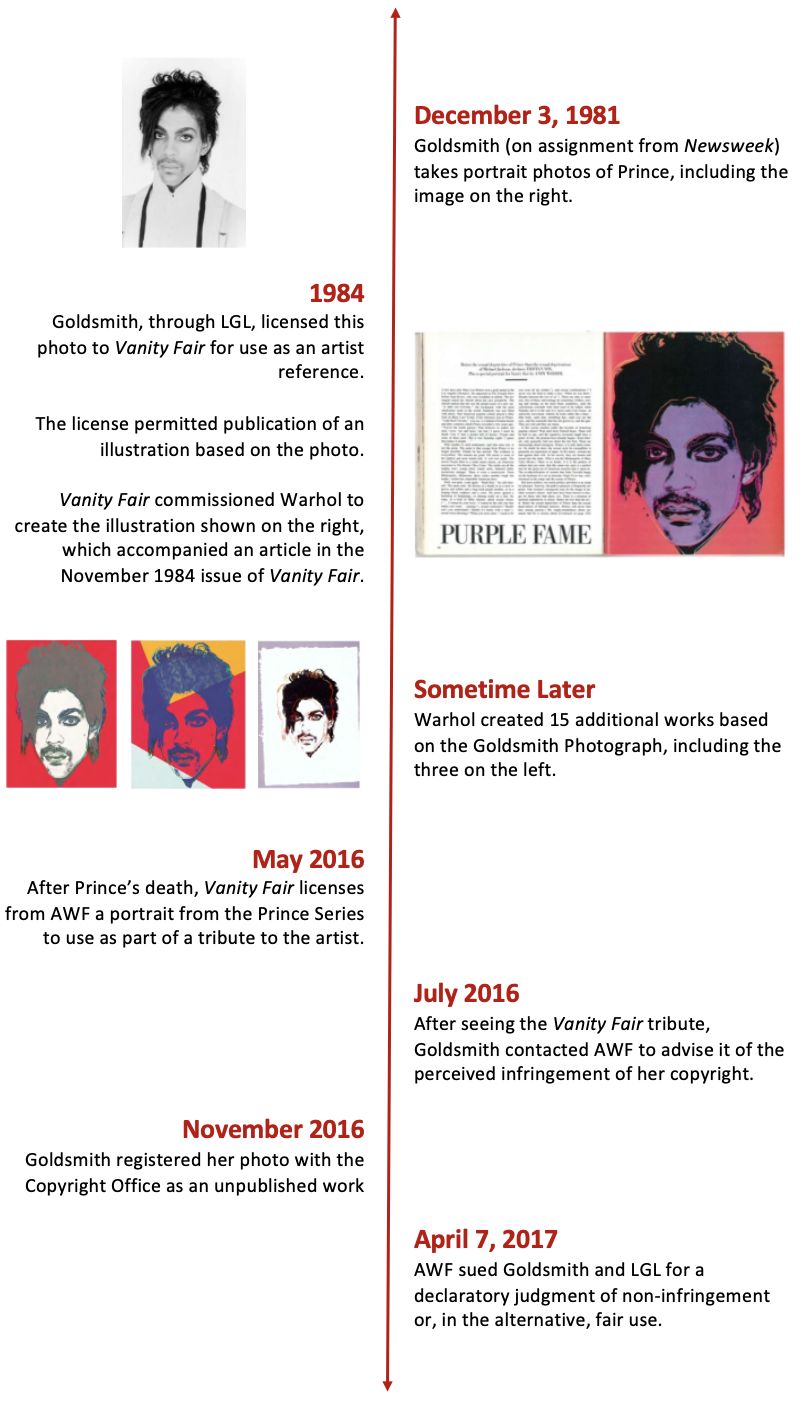
Fair Use
In the court below, (see our previous post), the district court held that Prince's use of Goldsmith's photograph was transformative because "[t]he Prince Series works can reasonably be perceived to have transformed Prince from a vulnerable, uncomfortable person" (as captured by Goldsmith) to the "iconic, larger-than-life figure" (as depicted in Warhol's series). The district court concluded that Warhol's alterations "result[ed] in an aesthetic and character different from the original," and added "something new to the world of art and the public would be deprived of this contribution if the works could not be distributed." The district court also found the other factors weighed in favor of a finding of fair use.
The Second Circuit reversed, finding that all four of the statutory fair use factors favored Goldsmith.
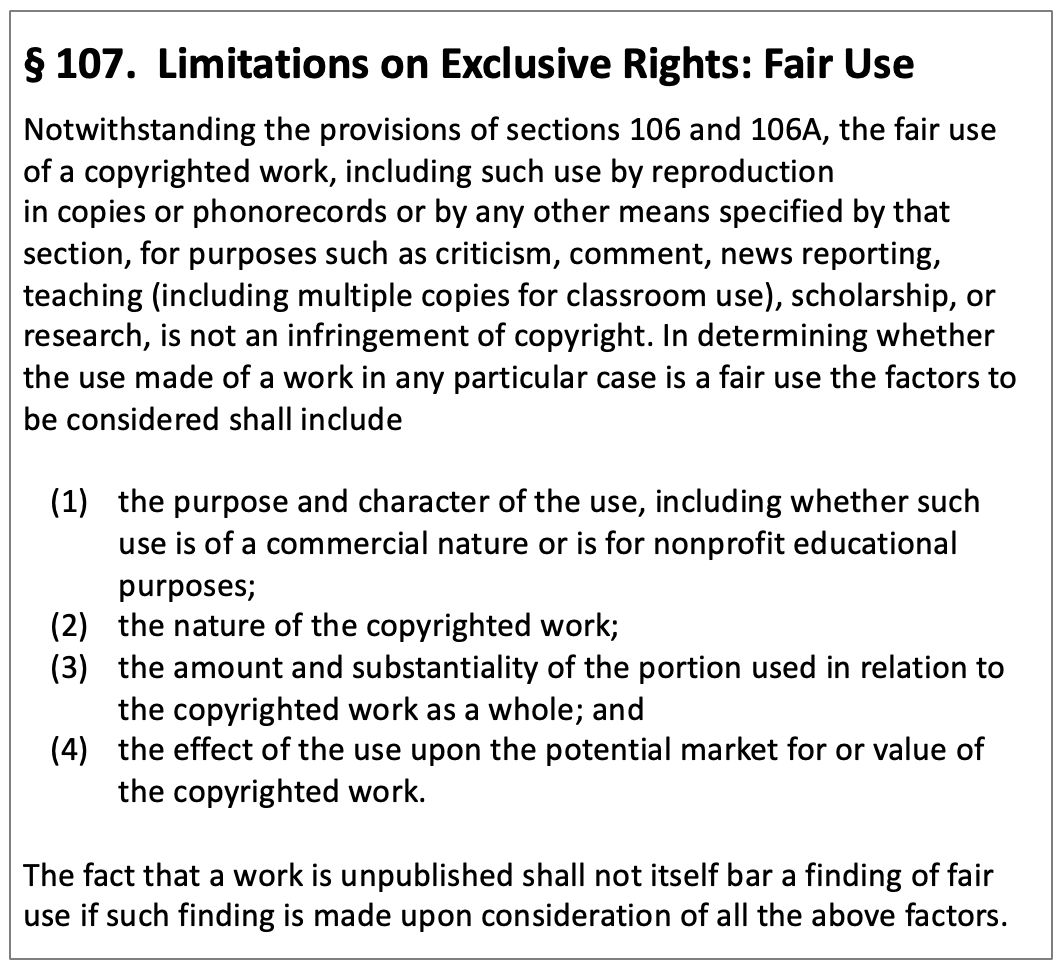
Purpose and Character of the Use.
The first factor requires courts to consider the extent to which the secondary work is "transformative." In reaching the conclusion that Warhol's series was transformative, the district court had relied chiefly on the Second Circuit's much-commented upon (and sometimes criticized) opinion in Cariou v. Prince (discussed at length in this post). Describing Cariou as the "high-water mark of our court's recognition of transformative works." the court used the case before it to "clarif[y]" the prior decision.
Cariou involved a series of collages and paintings in which appropriation artist Richard Prince (without permission) incorporated photographs of Rastafarian men taken by French artist Patrick Cariou. The Second Circuit found that in 25 of the 30 challenged works, Prince had made a transformative use of Cariou's photos, even though Prince's works did not directly comment on Cariou's photographs (which would have presented a more "straightforward" case for fair use). Instead, Prince's works were transformative because the artist had used Cariou's photos "as raw material, transformed in the creation of new information, new aesthetics, new insights and understanding."
The panel in Warhol held that the district court had incorrectly read Cariou as announcing a "bright line rule" that a secondary work was transformative as a matter of law when it adds a new aesthetic or new expression to its source material. While acknowledging that "the alteration of an original work with new expression, meaning, or message ... is the sine qua non of transformativeness," the court held that "it does not follow ... that any secondary work that adds a new aesthetic or new expression to its source material is necessarily transformative." Such an interpretation was overbroad and runs the risk of trampling upon the original artist's exclusive right to create derivative works. And because many (perhaps most) derivative works clearly add "something new" to the original, bright-line rules just aren't possible. (See this post for an exploration of the inherent tension between "transformative" fair uses and derivative works.)
In evaluating whether the secondary work is transformative or merely derivative of the primary work, courts typically consider the purpose of the two works. That inquiry can bear fruit in cases where the purposes are clearly different, such as in Bill Graham Archives v. Dorling Kindersley Ltd (use of images of concert posters in book about Grateful Dead "plainly different" from original purpose to advertise concerts) and Authors Guild v. HathiTrust (creation of a searchable "digital corpus" comprising scanned copies of tens of millions of books that enabled researchers, scholars, and others to pinpoint the exact page of any book in the catalogue on which the searched term was used was a "quintessentially transformative use" different from the purposes of the original works).
However, in cases (like this one) where the primary and secondary works are both visual arts, the inquiry into purpose is less useful since the works "at least at a high level of generality, share the same overarching purpose" (i.e., to serve as works of art). Acknowledging that the Second Circuit's prior visual arts cases provided "conflicting guidance," the court nevertheless found that that things became "simpler" (the court's word, not mine) once you compare the works in those case that were determined to have made transformative uses of the primary works and those that had not. Since a picture can be worth a 1000 words, I have included the images of the works at issue in these cases below.
Rogers v Koons (1992): The court held that appropriation artist Jeff Koons's use of the photo on the left to create the sculpture on the right was not transformative"
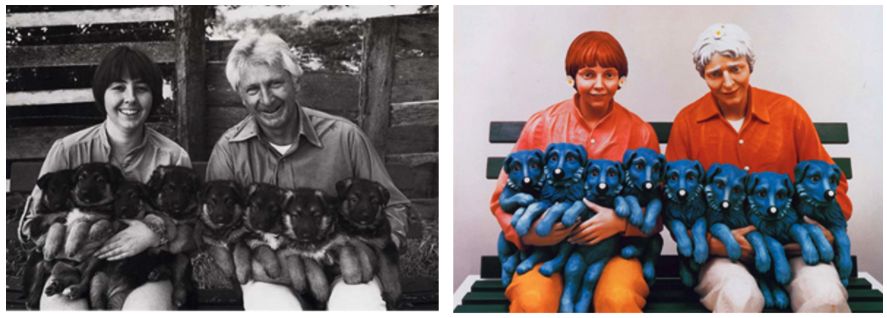
Blanch v. Coons (2006): The court held that Koons's use of the advertisement on the left was a transformative use when incorporated in the work on the right:
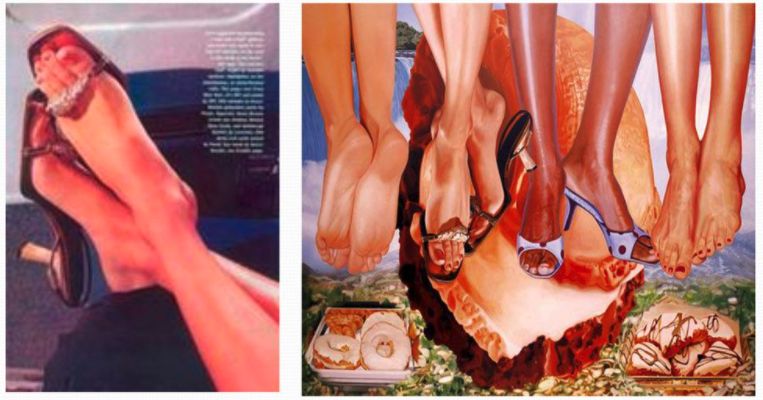
Cariou v. Prince (2013): Prince's use of Cariou's photos on the left to create the work on the right was held to be transformative as a matter of law:

By contrast, the Second Circuit held that it could not conclude as a matter of law that Prince's use of the photo on the left to create the work on the right was transformative:
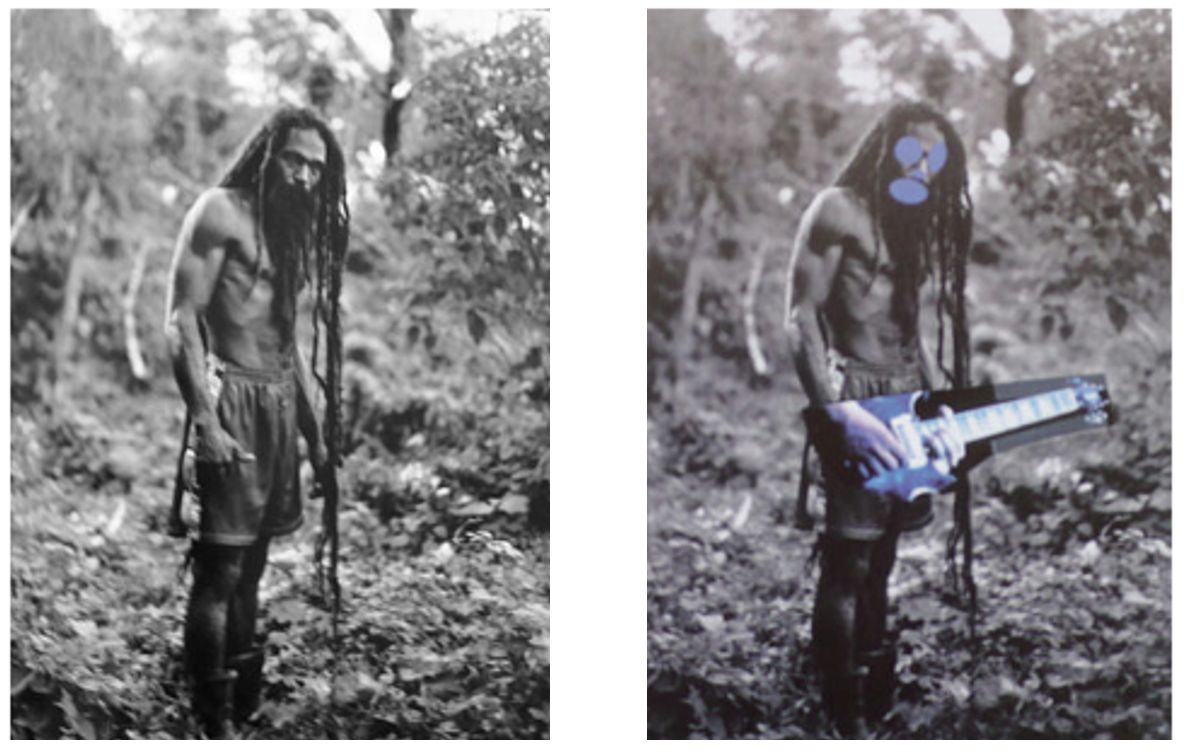
Based on this survey, the court concluded:
"A common thread running through these cases is that, where a secondary work does not obviously comment on or relate back to the original or use the original for a purpose other than that for which it was created, the bare assertion of a "higher or different artistic use," Rogers, 960 F.2d at 310, is insufficient to render a work transformative. Rather, the secondary work itself must reasonably be perceived as embodying an entirely distinct artistic purpose, one that conveys a "new meaning or message" entirely separate from its source material. While we cannot, nor do we attempt to, catalog all of the ways in which an artist may achieve that end, we note that the works that have done so thus far have themselves been distinct works of art that draw from numerous sources, rather than works that simply alter or recast a single work with a new aesthetic." (Emphasis supplied).
The district court had erred by holding that the Prince Series works were transformative because they could "reasonably be perceived to have transformed Prince from a vulnerable, uncomfortable person" (Goldsmith's alleged artistic intent) to "an iconic, larger-than-life figure" (Warhol's alleged artistic intent). Courts should not "assume the role of art critic and seek to ascertain the intent behind or meaning of the works at issue; instead, they "must examine how the works may reasonably be perceived" and "whether the secondary work's use of its source material is in service of a "fundamentally different and new" artistic purpose and character, such that the secondary work stands apart from the 'raw material' used to create it" (emphasis added). How different is "fundamentally different"? How far "apart" must the the secondary work "stand"? Considering the works that were determined to make fair use of their source material in Koons and Cariou, is the court saying that only collages in which snippets of the original works are used will qualify? Maybe not:
"Although we do not hold that the primary work must be "barely recognizable" within the secondary work, as was the case with the works held transformative in Cariou, the secondary work's transformative purpose and character must, at a bare minimum, comprise something more than the imposition of another artist's style on the primary work such that the secondary work remains both recognizably deriving from, and retaining the essential elements of, its source material."
Based on this "clarification," the panel concluded that the Prince Series did not make a transformative use of Goldsmith's portrait as a matter of law. Although Warhol's series transformed Goldsmith's photos in the sense that the final works "display the distinct aesthetic sensibility that many would immediately associate with Warhol's signature style," that was not enough. In the court's view, that type of "transformation" is more akin to the adaptation that occurs when a famous director turns a play into a movie. The movie may embody the director's signature style, but that doesn't change the fact that a movie adaptation is a "paradigmatically derivative work[]." The court supported its conclusion by noting the "overarching purpose and function" of Goldsmith's and Prince's works are "identical": "not merely in the broad sense that they are created as works of visual art, but also in the narrow but essential sense that they are portraits of the same person." And while the court cautioned that it did not "conclude that the Prince Series works are necessarily derivative works as a matter of law, they are much closer to presenting the same work in a different form, that form being a high-contrast screenprint, than they are to being works that make a transformative use of the original." At the end of the day, according to the panel, Warhol's series "retains the essential elements of the Goldsmith Photograph without significantly adding to or altering those elements" and Goldsmith's photo "remains the recognizable foundation upon which the Prince Series is built."
The Nature of the Copyrighted Work
The panel found that the second factor also favored Goldsmith, since the photograph was both creative and unpublished. The district court's conclusion that this factor was neutral - based upon its (erroneous) finding that the Prince's works were transformative and (to some degree) the fact that Goldsmith had licensed the image to Vanity Fair to use as an artist's comp - was error. Even though the second factor often is described as "of limited usefulness" where a creative work is being used for a transformative purpose, that characterization "relates only to the weight assigned to it, not whom it favors." The district court should have found this factor to favor Goldsmith "irrespective of whether it adjudged the Prince Series works transformative within the meaning of the first factor."
The Amount and Substantiality of the Use
The district court mistakenly ruled that the third factor favored AWF because Warhol had removed or minimized nearly all of the copyrightable elements in Goldsmith's photo through cropping and "flattening" the contrast, shading, and other expressive qualities of the photo. Specifically, AWF had argued that Warhol used only the "facts" of what Prince's face looks like (which are unprotectable) and not elements from Goldsmith's photo that were potentially protectable (such as "posing the subjects, lighting, angle, selection of film and camera, evoking the desired expression"). The court disagreed, noting that "while Goldsmith has no monopoly on Prince's face, the law grants her a broad monopoly on its image as it appears in her photographs of him." The court concluded that the Prince series borrows significantly from Goldsmith's photo, both quantitatively and qualitatively, and "are instantly recognizable as depictions or images of the Goldsmith Photograph itself." The court honed in on several similarities it considered to be telling, including:
"For example, the fact that Prince's mustache appears to be lighter on the right side of his face than the left is barely noticeable in the grayscale Goldsmith Photograph but is quite pronounced in the black-and-white Prince Series screenprints. Moreover, this feature of the Goldsmith Photograph is, again, not common to all other photographs of Prince even from that brief session. The similarity is not simply an artefact of what Prince's facial hair was like on that date, but of the particular effects of light and angle at which Goldsmith captured that aspect of his appearance."
The court contrasted Kienitz v. Sconnie Nation LLC, in which a panel of the Seventh Circuit held that a t-shirt design that incorporated a photograph in a manner that stripped away nearly every expressive element such that, "as with the Cheshire Cat, only the [subject's] smile remain[ed]," was fair use. "Warhol's rendition of the Goldsmith Photograph leaves quite a bit more detail, down to the glint in Prince's eyes where the umbrellas in Goldsmith's studio reflected off his pupils."
The Effect of the Use on the Market for the Original
The panel agreed the district court that the primary market (i.e., the market for the original works) for Warhol's series and Goldsmith's photo do not meaningfully overlap. However, the Prince series does threaten Goldsmith's ability to license her photo to magazines (like Vanity Fair) to illustrate articles about the singer since both works "are illustrations of the same famous musician with the same overlapping customer base." In addition, the Prince series was likely to harm the derivative market for licenses to others to create stylized derivatives of her photo (like the license Goldsmith had granted to Vanity Fair in 1984). Finally, the court was concerned that if the sort of copying in which Warhol had engaged were to become a "widespread practice," that would effectively destroy the market to create stylized derivatives since artists "could use such images for free, there would be little or no reason to pay for them."
Substantial Similarity
The court didn't stop there. Rather than remanding to the district court for further proceedings, the court went on to hold, as a matter of law, that Prince's series and Goldsmith's photo were substantially similar. The court rejected the invitation of AWF and various amici to employ the "more discerning observer" test (which is used when comparing works with "thinner" copyrights to ensure that non-copyrightable elements are identified and filtered out). According to the court, "photographs are generally viewed as creative aesthetic expressions of a scene or image and have long received thick copyright protection, . . . even though photographs capture images of reality." Employing, the standard "ordinary observer test," the court (echoing its analysis under the third fair use factor) concluded that "given the degree to which Goldsmith's work remains recognizable within Warhol's, there can be no reasonable debate that the works are substantially similar." Warhol did not copy merely the "idea" (i.e., Prince's likeness) conveyed in the Goldsmith photo; rather, he copied the photograph itself – i.e., "Goldsmith's particular expression of that idea."
Two Concurring Opinions
Judge Sullivan (joined by Judge Jacobs) filed a concurring opinion to "highlight" what he sees as "an overreliance on 'transformative use' in our fair use jurisprudence, generally," and to recommend that courts focus more on the fourth fair use factor. And Judge Jacobs wrote a short concurrence "to make a single point: the holding does not consider, let alone decide, whether the infringement encumbers the original Prince Series works that are in the hands of collectors or museums." The majority also had noted that Goldsmith did not seek equitable remedies such as prohibiting distribution or ordering destruction of Warhol's original works, "and it is highly unlikely that any court would deem them appropriate in this case." Maybe not. However, it is worth noting that this is precisely the remedy that the district court in Cariou had granted.
The Andy Warhol Foundation for the Visual Arts, Inc. v Goldsmith, __ F.3d __ (2d Cir. Mar. 26, 2021)
The content of this article is intended to provide a general guide to the subject matter. Specialist advice should be sought about your specific circumstances.

